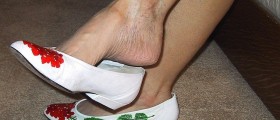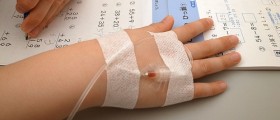Varicose Veins
Varicose veins are characterized by twisted and enlarged veins near the surface of the skin. Varicose veins are most common in the superficial veins of the legs.
This condition is usually treated with vein striping. Other treatments include sclerotherapy, laser surgery, catheter-assisted procedure, ambulatory phlebectomy, and endoscopic vein surgery.

Causes and Symptoms of Varicose Veins
Veins carry blood from the body to the heart in order to recirculate the blood. The vein valves prevent the blood from flowing retrograde.
Muscle contraction in the legs act as pumps and elastic vein walls help blood return to the heart. In varicose veins, these valves stop working properly when the walls of veins in the legs lose their elasticity stretch.
This condition is often caused by aging, pregnancy, obesity, menopause, and prolonged standing. Varicose veins are commonly seen in women and are considered to be hereditary.
Signs of varicose veins include veins that are blue or dark blue in color and veins that appear twisted and bulging. Painful signs and symptoms include heavy feeling in the legs, muscle cramping and swelling, increased pain after standing or sitting for an extended period of time, and itching around the vein.
Vein Stripping
Vein stripping is a surgical procedure performed to relieve the pain from varicose veins and to improve circulation. Stripping includes the removal of all or part of the saphenous vein's main trunk. This surgery is indicated if an ultrasound of the veins confirms malfunctioning and diseased veins.
It is an outpatient procedure but commonly conducted in the operating room. The patient can receive general or spinal anesthesia.
Surgical Procedure
During the surgery, an incision is made near the groin to access a saphenous vein. Then, the surgeon disconnects the saphenous vein from the femoral vein. The second incision is made below the knee and thin, flexible plastic wire is then inserted through the groin toward the other cut in the leg.
Wire is then pulled out and the vein with it. The surgeon closes the incisions with stitches and compression bandages are applied on the leg.
Complications of Vein Stripping
Vein stripping is generally safe. There are risks connected to general anesthesia such as allergic reactions to medicines, breathing problems, bleeding, and infection.
- Saphenous vein stripping is a simple, fast, safe, and standardized procedure for the treatment of varicose veins. It involves the interruption of the femoral-saphenous junction, stripping of the great saphenous vein, multiple removal of the tributary vein of the saphena and ligation of the extrafascial perforating veins.
- Complications (major and minor) are reported in approximately 18–20% of patients having standard varicose vein surgery. Major complication rates are reported in around 0.8% of patients, wound complications (rates vary from 3–10% and included infection, haematoma and abscess formation), thigh haematomas, nerve injury, vascular injury and injury to the common femoral vein occurring more frequently than arterial injury and venous thromboembolism.
- A total of 358 patients with varicose veins of the lower limbs treated between January 2001 and December 2011 at the Department of Advanced Biomedical Sciences of the ‘Federico II’ University in Naples (Italy) were retrospectively evaluated. 213 of these were patients under 65 years old and 145 patients were over this age. Patients with chronic venous disease C:2–6 A-S, E: P, A:S, P:S, P:R, according to the CEAP classification, were included. Stripping with preoperative Doppler or ultrasound evaluation was performed by the same surgeons for the same indications in both groups.
- Postoperative complications that occurred were: infection, haematoma, nerve injury (paresthesia and pain) and deep vein thrombosis. Although a trend towards better results was observed among the young patients, no significant differences were shown in our experience.
- In our study, we found no differences between elderly and younger patients with regard to postoperative morbidity and recurrence. The p value was non-significant and this suggests the safety and the efficacy of the saphenectomy among elderly subjects.
The risks for vein stripping include bruising or scaring, nerve injury, and return of the varicose vein over time.
After the Surgery
Surgical wounds are wrapped with bandages and compression stockings can be used to manage swelling and bleeding. Bandages remain for several days or weeks after the procedure.
The analgesic may be prescribed to the patient and he or she will be advised to take 10 to 12 walks, lasting from 5 to 10 minutes, every day.

















Your thoughts on this
Loading...